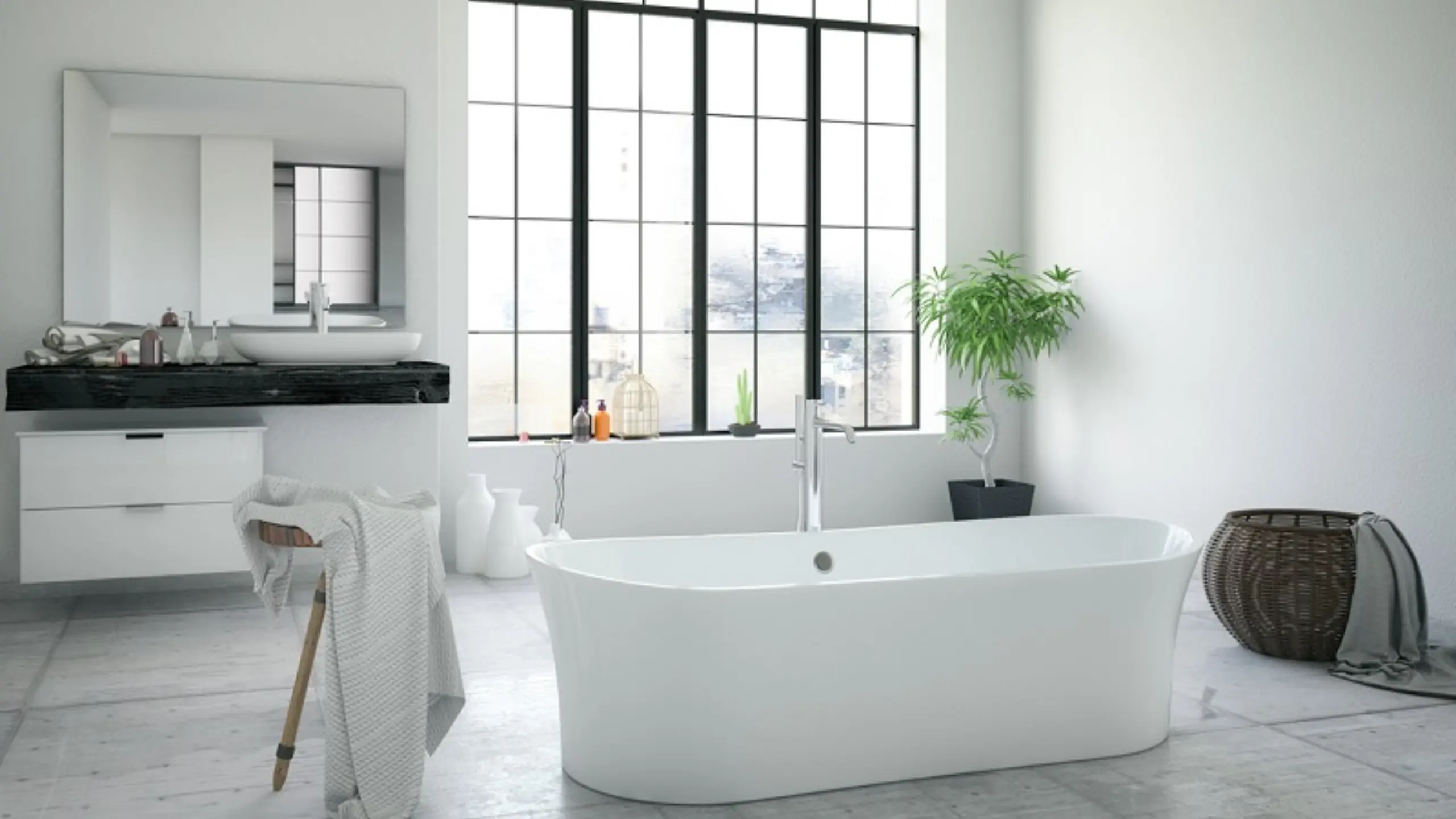Bathing is a ritual that has been practiced for centuries, providing relaxation, comfort, and rejuvenation. A bathtub plays a crucial role in this experience, as it sets the stage for a luxurious and soothing bath. However, with numerous options available in the market, choosing the right bathtub can be overwhelming. In this article, we will explore What to know about bathtubs, including different types and the best tub materials to help you make an informed decision.
Understanding Bathtub Types
1.1 Freestanding Bathtubs
Freestanding bathtubs are standalone fixtures that can be placed anywhere in the bathroom. They are available in various shapes and sizes, such as clawfoot, pedestal, or modern designs. Freestanding tubs offer a sense of elegance and are ideal for spacious bathrooms.
1.2 Alcove Bathtubs
Alcove bathtubs are designed to fit into a three-wall enclosure, with only one finished side exposed. They are commonly found in standard-sized bathrooms and are often combined with a showerhead.
1.3 Drop-In Bathtubs
Drop-in bathtubs are installed by dropping them into a deck or surround. They are versatile and can be customized with various materials and finishes to match your bathroom decor. Drop-in tubs provide flexibility in terms of installation and design.
1.4 Corner Bathtubs
Corner bathtubs are specifically designed to fit into the corner of a bathroom. They maximize space utilization and are a great choice for small bathrooms. Corner tubs come in different shapes, including triangular and oval, offering both functionality and style.
Exploring Bathtub Materials
2.1 Acrylic
Acrylic bathtubs are lightweight, durable, and cost-effective. They are available in a wide range of colors and styles, making them a popular choice among homeowners. Acrylic tubs retain heat well, providing a comfortable bathing experience.
2.2 Fiberglass
Fiberglass bathtubs are affordable and easy to install. They are made by layering fiberglass sheets with resin, resulting in a lightweight yet sturdy construction. Fiberglass tubs are resistant to chipping and cracking, making them a durable option.
2.3 Cast Iron
Cast iron bathtubs are known for their timeless elegance and exceptional durability. They are made by pouring molten iron into a mold, resulting in heavy and solid construction. Cast iron tubs retain heat effectively and are ideal for longer soaking baths.
2.4 Enamel-Coated Steel
Enamel-coated steel bathtubs offer a cost-effective and low-maintenance option. They are constructed by stamping steel sheets and then applying an enamel coating. These tubs are resistant to stains and scratches, ensuring a long-lasting finish.
2.5 Solid Surface
Solid surface bathtubs are made from a composite material, typically composed of minerals, resins, and pigments. They offer a seamless and modern appearance, with the ability to be customized in terms of shape and size. Solid surface tubs are non-porous and easy to clean.
2.6 Copper
Copper bathtubs exude luxury and sophistication. They are crafted from pure copper sheets and are naturally antimicrobial, making them a hygienic choice. Copper tubs develop a beautiful patina over time, adding to their charm.
Factors to Consider When Choosing a Bathtub
3.1 Available Space
Before selecting a bathtub, measure your bathroom space to ensure it can accommodate the desired tub size and shape. Consider doorways, plumbing fixtures, and any other spatial limitations that may affect installation.
3.2 Budget
Establishing a budget will help narrow down the options available. Different types of bathtubs and materials come with varying price ranges. It’s important to strike a balance between quality, functionality, and affordability.
3.3 Maintenance and Durability
Consider the level of maintenance required for the bathtub material you choose. Some materials may require regular cleaning or special care. Additionally, assess the durability of the tub to ensure it can withstand daily use and potential wear and tear.
3.4 Style and Aesthetics
Select a bathtub that complements your bathroom’s overall style and aesthetics. Consider the existing decor and choose a design that aligns with your preferences, whether it’s a classic, contemporary, or minimalist look.
3.5 Comfort and Ergonomics
Pay attention to the ergonomics of the bathtub, particularly if you plan on taking long, relaxing baths. Look for features like built-in armrests, lumbar support, and contoured designs that offer maximum comfort and support.
Popular Bathtub Styles and Designs
4.1 Clawfoot Bathtubs
Clawfoot bathtubs are characterized by their iconic claw-shaped feet. They evoke a sense of nostalgia and elegance, often associated with vintage or traditional bathroom designs. Clawfoot tubs can be freestanding or alcove-style, depending on your preference.
4.2 Soaking Tubs
Soaking tubs are deep and designed for full-body immersion. They allow you to submerge yourself in water, providing a therapeutic and relaxing bathing experience. Soaking tubs come in various shapes and sizes, catering to different preferences.
4.3 Whirlpool Tubs
Whirlpool tubs, also known as Jacuzzi tubs, are equipped with jets that create a soothing massage-like experience. They offer hydrotherapy benefits and are ideal for those seeking relief from muscle tension or stress. Whirlpool tubs are available in different sizes and configurations.
4.4 Walk-In Bathtubs
Walk-in bathtubs provide accessibility and safety features, making them suitable for individuals with mobility challenges or seniors. They feature a door that allows for easy entry and exit, along with built-in grab bars and non-slip surfaces.
4.5 Combination Tubs
Combination tubs offer the best of both worlds by incorporating features like a showerhead and bathtub into one unit. They are versatile and practical, catering to individuals who prefer the option to take a quick shower or a leisurely bath.
Benefits of Different Bathtub Materials
5.1 Acrylic: Lightweight and Versatile
Acrylic tubs are popular for their lightweight nature, making them easier to install and maneuver. They are also versatile in terms of design options, as acrylic can be molded into various shapes and sizes. Additionally, acrylic retains heat well, allowing for longer and more enjoyable baths.
5.2 Fiberglass: Affordable and Easy to Install
Fiberglass tubs are budget-friendly and lightweight, making them a cost-effective choice for many homeowners. They are relatively easy to install and can be customized with different colors and finishes. Fiberglass tubs are also known for their durability and resistance to cracks and chips.
5.3 Cast Iron: Durable and Excellent Heat Retention
Cast iron tubs are renowned for their durability and classic appeal. They have excellent heat retention properties, keeping the water warmer for a more extended period. Cast iron is a sturdy material that resists scratches and stains, ensuring longevity.
5.4 Enamel-Coated Steel: Cost-Effective and Stain-Resistant
Enamel-coated steel tubs are an affordable option, making them suitable for budget-conscious individuals. They have a sleek and glossy finish and are resistant to stains and scratches. However, they may not retain heat as effectively as other materials.
5.5 Solid Surface: Customizable and Modern
Solid surface tubs offer a modern and seamless aesthetic. They can be customized to fit specific dimensions and come in a range of colors and textures. Solid surface materials are non-porous, making them resistant to stains and easy to maintain.
5.6 Copper: Elegant and Naturally Antibacterial
Copper tubs exude luxury and sophistication with their warm, metallic tones. They are naturally antimicrobial, inhibiting the growth of bacteria and fungi. Over time, copper develops a unique patina that adds to its visual appeal.
Maintenance Tips for Bathtubs
6.1 Cleaning and Preventing Stains
Regular cleaning is essential to maintain the beauty and hygiene of your bathtub. Use non-abrasive cleaners and avoid harsh chemicals that may damage the surface. Wipe away any soap scum or residue promptly to prevent stains.
6.2 Repairing Minor Damages
In the event of minor damages like chips or scratches, repair them promptly to prevent further deterioration. Follow the manufacturer’s instructions or consult a professional for guidance on repairing specific materials.
6.3 Proper Drainage and Plumbing
Ensure that your bathtub’s drainage system is functioning properly to prevent water pooling or leaks. Regularly check the plumbing connections and address any issues promptly to avoid water damage.
6.4 Avoiding Abrasive Cleaners
Avoid using abrasive cleaners or scrub brushes that can scratch or damage the surface of your bathtub. Opt for mild, non-abrasive cleaning solutions that are suitable for the specific material of your tub.
Enhancing the Bathtub Experience
7.1 Bath Bombs and Essential Oils
Add a touch of luxury to your bath by using bath bombs or essential oils. These aromatic additions can create a spa-like ambiance and promote relaxation.
7.2 Bath Caddies and Accessories
Invest in a bath caddy or tray to hold your bath essentials, such as a book, wine glass, or bath products. These accessories can enhance your bathing experience by providing convenience and organization.
7.3 Relaxing Lighting and Ambiance
Set the mood in your bathroom with soft and warm lighting. Consider installing dimmer switches or using candles to create a relaxing and soothing atmosphere.
7.4 Soft Towels and Robes
Wrap yourself in luxury by using soft, plush towels and robes. Invest in high-quality materials that will make you feel pampered and comfortable after your bath.
7.5 Music and Entertainment Options
Bring your favorite tunes or audiobooks into the bathroom with waterproof speakers or devices. Create a personalized playlist or choose an audiobook that can accompany your relaxing bath.
Conclusion
Choosing the perfect bathtub for your needs and preferences involves considering factors such as bathtub types, materials, available space, budget, and maintenance requirements. By understanding the various options available and assessing your personal preferences, you can select a bathtub that enhances your bathing experience and complements your bathroom decor. Remember to prioritize comfort, durability, and style to create a bathing oasis in your home



